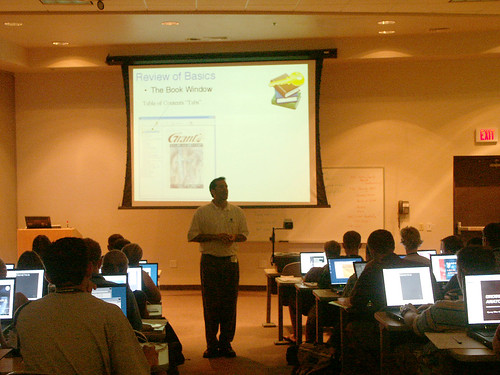 |
|
Interestingly, each computer has something different on the screen. This is probably fine. Students should be free to use their machines as a thought extensions, utilizing the tools in ways that make sense to them, to help them make sense of what’s being taught. (( Richbourg, Smyth. “What I Do.” Flickr. 23 Apr 2005. Web. 7 Nov 2009. <http://www.flickr.com/photos/tsmyther/10599159/>. )) |
My week is over, with gigs in Raleigh, Long Island, and three full days around Edmonton, Canada. I take the elevator down in about ten minutes to grab a cab for the Edmonton airport, landing in Raleigh at about 4:40 PM. So I have ten minutes, and its the first ten minutes I’ve had in a week to think about blogging.
So I decided to check for comments on 2¢ Worth that needed moderating, and was surprised to find a number of them. Alas, I haven’t gotten anywhere, because the first one grabbed my attention, a comment from Susi, a teacher in Bangkok. It was a response to my blog post on the difference between Computer Applications and Computer Application (minus the ending “s”), and she implied that to learn a language, such as Japanese, and to become fluent in the language to any degree, it takes more than just teaching it. It has to become a tool for the learning.
Students who become fluent in reading, do so because they read, not because they were taught the basic reading skills. Of course, it wouldn’t have happened without having been taught the basic reading skills. But they become fluent because they are required to read for the rest of their formal education and beyond.
If we expect students to become fluent in the broader and equally critical information and technology skills of being literate in a networked, digital, and abundant (contemporary) information environment, then they should be required to use those skills in all of their formal education, just like reading. Reading, for education, is a learning literacy. Reading, processing, and expressing knowledge in a networked, digital, and abundant information landscape are equally important learning skills — learning literacies.
Our stated goal, right now, in every school and school district, should be for every student to walk into their classrooms with a computer (literacy machine, not a handheld) under their arm. It’s no long a matter of “if” — it’s “when.”
..because literacy skills are meaningless until they become literacy habits.

Powered by ScribeFire.


 Twitter Camp (left) with the emerging tweets on the main screen as people were ambling into the general keynote presentations. The result was an archive of 206 (at this moment) short messages about the conference and it’s contents, posted before, during, and after the gathering by people who were there and by many who were following the event from afar.
Twitter Camp (left) with the emerging tweets on the main screen as people were ambling into the general keynote presentations. The result was an archive of 206 (at this moment) short messages about the conference and it’s contents, posted before, during, and after the gathering by people who were there and by many who were following the event from afar.